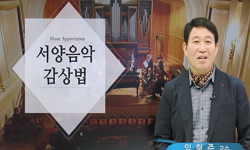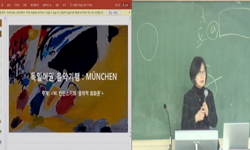In terms of technique, Johannes Brahms(1833-1897)'s musical works are characterized by frequent use of octaves, 3rd and 6th parallel harmonies, recurring and overlapping melodic lines, syncopated notes, dispersive choral tones, as well as polar- and a...
http://chineseinput.net/에서 pinyin(병음)방식으로 중국어를 변환할 수 있습니다.
변환된 중국어를 복사하여 사용하시면 됩니다.
- 中文 을 입력하시려면 zhongwen을 입력하시고 space를누르시면됩니다.
- 北京 을 입력하시려면 beijing을 입력하시고 space를 누르시면 됩니다.
부가정보
다국어 초록 (Multilingual Abstract)
The well-organized style revealed in the works of senior composers such as Beethoven, Schumann, and Schubert greatly influenced Brahms' music in terms of form. Other major elements that influenced his musical compositions are the strong national spirit contained in German folk songs, as well as the characteristic irregular rhythm of the Hungarian folk music that Brahms encountered in his childhood, whose influence can be found in many of his works.
Brahms reveals his musical color through the use of harmonies that give a sense of variety of tonality, the widening of the range of tonality by harmonizing using 3rd and 6th intervals, the use of accents and dotted lines, triplet notes, successive eighth notes, and progressing to a low bass. Brahms’s work reveals the influence of romanticism in the romantic colors of its melody, harmony, and structure, but shows extreme classicism in the form of his compositions.
The music of Brahms, who lived in the era of romanticism while pursuing the musical form of classicism and moderation, can be clearly divided into a first, second, and third period.
Brahms's personality is clearly visible by his composition of mainly sonatas in the first period, variations in the second, and character pieces in the third period.
The subject of this paper, Rhapsody Op. 79, belongs to the later period, and No. 1 and No. 2 are both composed of large-scale single movements with passionate minor keys. The first song consists of a total of 235 measures and is in the complex ternary form of the A-B-A′ Coda.
The second composition consists of a more compact total of 124 measures, and is composed according to a strict sonata form, following the classic three-part structure consisting of exposition, development, and recapitulation, followed by a coda. In No. 2, it can be seen that the structural texture of the music is more revealed and a lower range is used compared to No. 1.
In this thesis, we will attempt to more deeply understand the world of Brahms’s piano works by studying Rhapsody Op. 79, and examining the characteristics and forms of the aforementioned pair of compositions.
In terms of technique, Johannes Brahms(1833-1897)'s musical works are characterized by frequent use of octaves, 3rd and 6th parallel harmonies, recurring and overlapping melodic lines, syncopated notes, dispersive choral tones, as well as polar- and alternating rhythms.
The well-organized style revealed in the works of senior composers such as Beethoven, Schumann, and Schubert greatly influenced Brahms' music in terms of form. Other major elements that influenced his musical compositions are the strong national spirit contained in German folk songs, as well as the characteristic irregular rhythm of the Hungarian folk music that Brahms encountered in his childhood, whose influence can be found in many of his works.
Brahms reveals his musical color through the use of harmonies that give a sense of variety of tonality, the widening of the range of tonality by harmonizing using 3rd and 6th intervals, the use of accents and dotted lines, triplet notes, successive eighth notes, and progressing to a low bass. Brahms’s work reveals the influence of romanticism in the romantic colors of its melody, harmony, and structure, but shows extreme classicism in the form of his compositions.
The music of Brahms, who lived in the era of romanticism while pursuing the musical form of classicism and moderation, can be clearly divided into a first, second, and third period.
Brahms's personality is clearly visible by his composition of mainly sonatas in the first period, variations in the second, and character pieces in the third period.
The subject of this paper, Rhapsody Op. 79, belongs to the later period, and No. 1 and No. 2 are both composed of large-scale single movements with passionate minor keys. The first song consists of a total of 235 measures and is in the complex ternary form of the A-B-A′ Coda.
The second composition consists of a more compact total of 124 measures, and is composed according to a strict sonata form, following the classic three-part structure consisting of exposition, development, and recapitulation, followed by a coda. In No. 2, it can be seen that the structural texture of the music is more revealed and a lower range is used compared to No. 1.
In this thesis, we will attempt to more deeply understand the world of Brahms’s piano works by studying Rhapsody Op. 79, and examining the characteristics and forms of the aforementioned pair of compositions.
국문 초록 (Abstract)
브람스의 음악적 특징으로는 다양한 조성감을 느끼게 해주는 화성을 사용하고 3도, 6도의 화성기법을 통하여 조성영역을 넓히고, 악센트와 부점, 셋잇단음표, 연속적인 8분음표의 사용, 낮은 베이스로 진행하여 그의 음악적 색채를 드러낸다.
기교적인 면에서는 옥타브, 3도와 6도 병행 진행, 반복적으로 중복적인 선율선, 당김음, 화음의 분산 음형, 폴라 리듬 및 교차되는 리듬의 잦은 사용으로 정리 할 수 있다.
고전주의의 음악 형식과 절제를 추구하면서도 낭만주의 시대를 살았던 브람스의 음악은 뚜렷하게 제 1기, 제 2기, 제 3기로 구분할 수 있다.
제 1기에는 소나타 작품, 제 2기에서는 변주곡, 후기에 해당하는 제 3기에는 성격소품들을 주로 작곡하여 브람스의 개성을 두드러지게 알 수 있다.
본 논문의 주제인 Rhapsody Op. 79 는 B minor의 악곡으로 전체적인 구조는 코다를 가지는 A-B-A의 3부 형식이다. A 부분은 a-b-a′로 나누어지고 b 부분에서 선율의 대조가 나타난다. 그리고 이 서정적인 선율은 B부분에서도 지속적으로 나타나게 되면서 악곡 전체에 통일성을 부여하고 있다. 그리고 코다에서 다시 이 서정적인 선율이 나타나며 A부분을 끝맺는다.
Rhapsody Op. 79 No. 2는 G minor의 소나타 형식으로 작곡되었으나 명확한 장조 조성이 확립되는 경우가 없으며 모두 시작 부분에는 조성이 모호하게 나타나는 것이 특징이다. 그리고 발전부에서는 삽입된 부분의 느낌을 주고 있다. 화성은 폭넓은 분산화음과 낮은 저음 성부의 진행 등의 사용으로 음향을 더욱 풍부하게 만들어내고 있다.
본 논문에서는 두 개의 광시곡(狂詩曲)들을 연구함으로써 곡의 특징과 형식을 살펴보고, 브람스의 피아노 작품 세계를 이해하여 보고자 한다
브람스 (Johannes Brahms, 1833-1897)의 음악작품은 선율과, 화성, 짜임새에서 낭만적인 색채를 드러내면서도 음악의 형식에서는 극도의 고전주의의 모습을 보여준다. 그의 음악 작곡에 영향을 미치...
브람스 (Johannes Brahms, 1833-1897)의 음악작품은 선율과, 화성, 짜임새에서 낭만적인 색채를 드러내면서도 음악의 형식에서는 극도의 고전주의의 모습을 보여준다. 그의 음악 작곡에 영향을 미치는 요소는 민족정신이 포함된 독일의 민요나 브람스가 유년 시절에 접하였던 헝가리 민속음악의 특징적인 불규칙 리듬이며, 그의 여러 작품에서 종종 확인할 수 있다.
브람스의 음악적 특징으로는 다양한 조성감을 느끼게 해주는 화성을 사용하고 3도, 6도의 화성기법을 통하여 조성영역을 넓히고, 악센트와 부점, 셋잇단음표, 연속적인 8분음표의 사용, 낮은 베이스로 진행하여 그의 음악적 색채를 드러낸다.
기교적인 면에서는 옥타브, 3도와 6도 병행 진행, 반복적으로 중복적인 선율선, 당김음, 화음의 분산 음형, 폴라 리듬 및 교차되는 리듬의 잦은 사용으로 정리 할 수 있다.
고전주의의 음악 형식과 절제를 추구하면서도 낭만주의 시대를 살았던 브람스의 음악은 뚜렷하게 제 1기, 제 2기, 제 3기로 구분할 수 있다.
제 1기에는 소나타 작품, 제 2기에서는 변주곡, 후기에 해당하는 제 3기에는 성격소품들을 주로 작곡하여 브람스의 개성을 두드러지게 알 수 있다.
본 논문의 주제인 Rhapsody Op. 79 는 B minor의 악곡으로 전체적인 구조는 코다를 가지는 A-B-A의 3부 형식이다. A 부분은 a-b-a′로 나누어지고 b 부분에서 선율의 대조가 나타난다. 그리고 이 서정적인 선율은 B부분에서도 지속적으로 나타나게 되면서 악곡 전체에 통일성을 부여하고 있다. 그리고 코다에서 다시 이 서정적인 선율이 나타나며 A부분을 끝맺는다.
Rhapsody Op. 79 No. 2는 G minor의 소나타 형식으로 작곡되었으나 명확한 장조 조성이 확립되는 경우가 없으며 모두 시작 부분에는 조성이 모호하게 나타나는 것이 특징이다. 그리고 발전부에서는 삽입된 부분의 느낌을 주고 있다. 화성은 폭넓은 분산화음과 낮은 저음 성부의 진행 등의 사용으로 음향을 더욱 풍부하게 만들어내고 있다.
본 논문에서는 두 개의 광시곡(狂詩曲)들을 연구함으로써 곡의 특징과 형식을 살펴보고, 브람스의 피아노 작품 세계를 이해하여 보고자 한다
목차 (Table of Contents)
- I. 서론 1
- II. 브람스의 생애와 피아노 음악 3
- Ⅲ. 브람스 피아노 음악의 특징 5
- I. 서론 1
- II. 브람스의 생애와 피아노 음악 3
- Ⅲ. 브람스 피아노 음악의 특징 5
- 1. 제 1기 6
- 2. 제 2기 7
- 3. 제 3기 10
- Ⅳ. 랩소디 Op. 79에 관한 분석 12
- 1. 랩소디의 기원과 고찰 12
- 2. 작품배경 14
- 3. Brahms Rhapsodies, Op. 79의 작품설명 15
- 1) Op. 79 No. 1 16
- 2) Op. 79 No. 2 27
- Ⅴ. 결론 38
- 참고문헌 40
- Abstract 42












